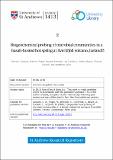Files in this item
Biogeochemical probing of microbial communities in a basalt-hosted hot spring at Kverkfjöll volcano, Iceland
Item metadata
| dc.contributor.author | Cousins, Claire R. | |
| dc.contributor.author | Fogel, Marilyn | |
| dc.contributor.author | Bowden, Roxane | |
| dc.contributor.author | Crawford, Ian | |
| dc.contributor.author | Boyce, Adrian | |
| dc.contributor.author | Cockell, Charles | |
| dc.contributor.author | Gunn, Matthew | |
| dc.date.accessioned | 2019-05-31T23:38:26Z | |
| dc.date.available | 2019-05-31T23:38:26Z | |
| dc.date.issued | 2018-09 | |
| dc.identifier | 253289654 | |
| dc.identifier | 3d16ad7b-9b86-4b7e-a816-b6bf112cc209 | |
| dc.identifier | 85052496419 | |
| dc.identifier | 000441436700004 | |
| dc.identifier.citation | Cousins , C R , Fogel , M , Bowden , R , Crawford , I , Boyce , A , Cockell , C & Gunn , M 2018 , ' Biogeochemical probing of microbial communities in a basalt-hosted hot spring at Kverkfjöll volcano, Iceland ' , Geobiology , vol. 16 , no. 5 , pp. 507-521 . https://doi.org/10.1111/gbi.12291 | en |
| dc.identifier.issn | 1472-4677 | |
| dc.identifier.other | crossref: 10.1111/gbi.12291 | |
| dc.identifier.other | ORCID: /0000-0002-3954-8079/work/60196580 | |
| dc.identifier.uri | https://hdl.handle.net/10023/17796 | |
| dc.description | This work was funded by a The Leverhulme Trust Research Project Grant to I. Crawford (F/07 112/AA). C. Cousins is funded by a Royal Society of Edinburgh Research Fellowship. Stable isotope analyses at the Carnegie Institution of Washington, USA, were funded by a grant from the W. M. Keck Foundation (2007-6-29) and through the NASA Astrobiology grant (NNH082ZDA0002C) to M. Fogel. | en |
| dc.description.abstract | We investigated bacterial and archaeal communities along an ice‐fed surficial hot spring at Kverkfjöll volcano—a partially ice‐covered basaltic volcano at Vatnajökull glacier, Iceland, using biomolecular (16S rRNA, apsA, mcrA, amoA, nifH genes) and stable isotope techniques. The hot spring environment is characterized by high temperatures and low dissolved oxygen concentrations at the source (68°C and <1 mg/L (±0.1%)) changing to lower temperatures and higher dissolved oxygen downstream (34.7°C and 5.9 mg/L), with sulfate the dominant anion (225 mg/L at the source). Sediments are comprised of detrital basalt, low‐temperature alteration phases and pyrite, with <0.4 wt. % total organic carbon (TOC). 16S rRNA gene profiles reveal that organisms affiliated with Hydrogenobaculum (54%–87% bacterial population) and Thermoproteales (35%–63% archaeal population) dominate the micro‐oxic hot spring source, while sulfur‐oxidizing archaea (Sulfolobales, 57%–82%), and putative sulfur‐oxidizing and heterotrophic bacterial groups dominate oxic downstream environments. The δ13Corg (‰ V‐PDB) values for sediment TOC and microbial biomass range from −9.4‰ at the spring's source decreasing to −12.6‰ downstream. A reverse effect isotope fractionation of ~3‰ between sediment sulfide (δ34S ~0‰) and dissolved water sulfate (δ34S +3.2‰), and δ18O values of ~ −5.3‰ suggest pyrite forms abiogenically from volcanic sulfide, followed by abiogenic and microbial oxidation. These environments represent an unexplored surficial geothermal environment analogous to transient volcanogenic habitats during putative “snowball Earth” scenarios and volcano–ice geothermal environments on Mars. | |
| dc.format.extent | 2595088 | |
| dc.language.iso | eng | |
| dc.relation.ispartof | Geobiology | en |
| dc.subject | QE Geology | en |
| dc.subject | QH301 Biology | en |
| dc.subject | QD Chemistry | en |
| dc.subject | NDAS | en |
| dc.subject.lcc | QE | en |
| dc.subject.lcc | QH301 | en |
| dc.subject.lcc | QD | en |
| dc.title | Biogeochemical probing of microbial communities in a basalt-hosted hot spring at Kverkfjöll volcano, Iceland | en |
| dc.type | Journal article | en |
| dc.contributor.sponsor | Science & Technology Facilities Council | en |
| dc.contributor.sponsor | The Royal Society of Edinburgh | en |
| dc.contributor.institution | University of St Andrews. School of Earth & Environmental Sciences | en |
| dc.contributor.institution | University of St Andrews. St Andrews Centre for Exoplanet Science | en |
| dc.identifier.doi | 10.1111/gbi.12291 | |
| dc.description.status | Peer reviewed | en |
| dc.date.embargoedUntil | 2019-06-01 | |
| dc.identifier.grantnumber | ST/P001270/1 | en |
| dc.identifier.grantnumber | en |
This item appears in the following Collection(s)
Items in the St Andrews Research Repository are protected by copyright, with all rights reserved, unless otherwise indicated.

